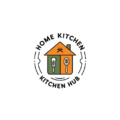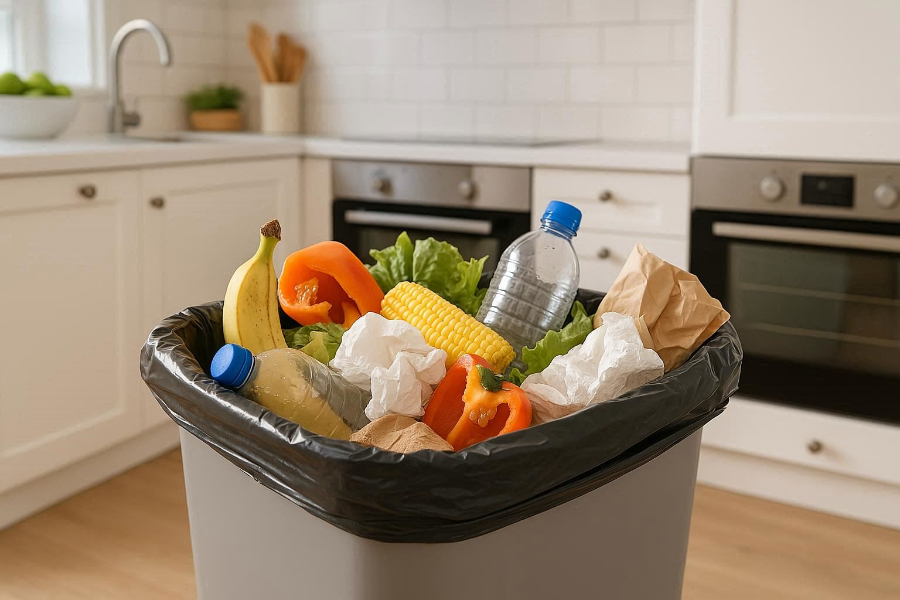When it comes to maintaining an organized and efficient kitchen, one essential item often overlooked is the kitchen trash can. It might not be the most glamorous part of your kitchen, but choosing the right size can significantly impact your kitchen’s waste management and overall functionality. The key to choosing the best kitchen trash can lies in understanding the different sizes available and matching them with your household’s needs.
In this blog post, we’ll walk you through everything you need to know about kitchen trash can sizes. From common sizes to how to measure them and important factors to consider, this guide will help you make an informed choice. Let’s dive in!
Understanding Kitchen Trash Can Sizes
Choosing the right size trash can for your kitchen is more important than it might seem. Not only does the right size help keep your space organized, but it also ensures you Cleaning Guide for Home & Kitchen don’t have to deal with frequent trash overflows or waste management hassles. A trash can that’s too small might require emptying too often, while one that’s too large might waste precious space in your kitchen.
Common Kitchen Trash Can Sizes
Kitchen trash cans come in a variety of sizes, ranging from small cans for compact spaces to large bins that can handle the waste of a busy household. Here’s a breakdown of the most common kitchen trash can sizes and their uses:
- 5-Gallon: This is the smallest option, typically ideal for small kitchens, apartments, or single-person households.
- 8-Gallon: Slightly larger than the 5-gallon, this size works well in smaller kitchens or for couples who generate less waste.
- 10-Gallon: Perfect for smaller families or kitchens that produce moderate waste, offering a good balance between compactness and capacity.
- 13-Gallon: The most common kitchen trash can size. It fits well in most kitchen spaces and works for average-sized families or individuals who cook frequently.
- 20-Gallon: Larger than the typical 13-gallon, this size is suitable for larger families or high-traffic kitchens with more waste to manage.
Each size serves a different need, so it’s essential to evaluate your space and household size to pick the best fit.
How to Measure a Kitchen Trash Can
When choosing a trash can, it’s important to understand how its size is measured. Kitchen trash cans are usually measured by their volume in gallons. However, the volume can vary slightly between manufacturers due to differences in the design and shape of the can. Here’s how to measure:
- Width and Depth: Measure the base of the trash can. For rectangular cans, width and depth are important in assessing fit.
- Height: Measure the height from the base to the top rim to determine if the can fits in your designated kitchen space.
Manufacturers often provide volume measurements based on capacity, so check the label or product details to find the can’s total volume.
Standard Size for Kitchen Trash Cans
Among all the sizes, the 13-gallon trash can is by far the most popular and widely used in kitchens. Let’s dive into why this size is so common and explore other popular options.
The 13-Gallon Trash Can: The Most Common Size
Why is the 13-gallon size so popular? It’s simple: this size fits most kitchens and is the perfect match for an average-sized family. A 13-gallon trash can is large enough to handle daily waste from regular cooking, packaging, and food scraps but still compact enough to fit under most kitchen counters or in a pantry.
For many households, a 13-gallon trash can provides a practical solution to waste disposal. It uses a standard 13-gallon trash bag, which makes shopping for bags easy and inexpensive. This size also requires emptying every few days—frequent enough to avoid overflow but not so often that it’s a hassle.
Other Popular Kitchen Trash Can Sizes
5- and 8-Gallon Trash Cans
These smaller options are best for individuals or couples living in smaller apartments or kitchens with limited space. A 5- or 8-gallon trash can is great for those who don’t generate much waste but still need a container to manage kitchen scraps.
- 5-Gallon: Ideal for small kitchens or single-person households.
- 8-Gallon: Slightly larger, but still compact, making it a good choice for couples.
10-Gallon Trash Cans
A 10-gallon trash can works well in moderate-sized households. It provides a good balance between space-saving and waste management without being too large. This size is often used in kitchens with average waste output, like those of families who cook often but don’t have excessive waste.
20-Gallon Trash Cans
Larger families or households with high kitchen traffic often opt for a 20-gallon trash can. This size can handle more waste without the need for frequent emptying, making it an ideal choice for busy kitchens or those that produce significant amounts of food waste.
Factors to Consider When Choosing a Kitchen Trash Can Size
When choosing the right size for your kitchen trash can, there are several factors to consider. Understanding your kitchen layout, waste generation habits, and available space will help you make the right choice.
Household Size and Waste Volume
The number of people in your household plays a significant role in determining the ideal size for your kitchen trash can. A family of four or more is likely to generate more waste than a single person or couple, so a larger trash can will be necessary. On the other hand, a single person or couple can manage with a smaller 5- or 8-gallon trash can.
Available Kitchen Space
Think about where you plan to place the trash can in your kitchen. If you’re limited by space, a smaller option might be your best bet. Under-counter or corner placement often suits smaller cans. If you have more space or are willing to leave the trash can out in the open, a larger option may be suitable.
Frequency of Waste Disposal
If you’re someone who tends to take out the trash daily or every other day, a smaller trash can might work. However, if you don’t mind letting trash pile up for a few days, a larger can could be more suitable. Larger trash cans need less frequent emptying, but they take up more space, so keep that in mind.
Type of Waste Generated
Not all waste is the same! Consider what type of waste you typically generate. If you compost or recycle, you may need separate containers, which could affect your trash can choice. Households with a lot of packaging or recyclable materials might need a smaller trash can for non-recyclable waste but larger bins for recyclables and composting.
Are There Other Kitchen Trash Can Features to Consider?
Beyond size, there are other important features to think about when selecting a kitchen trash can.
Type of Lid (Swing, Step, or Touchless)
Trash can lids come in several types, each with its pros and cons:
- Swing Lid: Easy to use, but not the most secure option for containing odors.
- Step Lid: Offers hands-free operation but takes up more space.
- Touchless Lid: Perfect for hygienic and hands-free disposal, ideal for high-traffic kitchens.
Each lid type affects the functionality and cleanliness of your kitchen trash can, so choose according to your needs.
Material Choices for Kitchen Trash Cans
Trash cans come in a variety of materials, including plastic, stainless steel, and even ceramic. Stainless steel is durable, easy to clean, and aesthetically pleasing, but it’s often pricier. Plastic cans are lightweight and more affordable, but they may wear out more quickly.
Trash Can Shape and Design
The shape and design of your kitchen trash can can also affect its functionality. Rectangular or square cans often fit better in corners or under counters, while round cans are easier to access. Consider your kitchen layout and how the design will fit into your space.
How Many Gallons Does a Kitchen Trash Can Really Need?
So, how do you figure out the exact size of trash can your kitchen needs? Here’s a simple way to assess it:
Assessing Your Kitchen’s Needs
A general rule of thumb is to choose a 13-gallon trash can for average-sized households. If your family is small, you might opt for something smaller like a 5- or 8-gallon trash can. If your kitchen generates a lot of waste or you have a large family, a 20-gallon trash can might be necessary.
Tips for Using Smaller or Larger Trash Cans Efficiently
If you’re working with a smaller can, be sure to optimize space by compacting trash and avoiding overstuffing. For larger cans, you’ll want to make sure you empty it regularly to prevent unpleasant odors from building up.
FAQ: How Many Gallons is a Kitchen Trash Can?
Q1: What is the standard size for a kitchen trash can?
The most common kitchen trash can size is 13 gallons, which fits most households and uses standard 13-gallon trash bags.
Q2: How do I know what size trash can I need for my kitchen?
Consider your household size, available kitchen space, and how often you dispose of trash. A 13-gallon can typically works well for a medium-sized family.
Q3: Can a 5-gallon trash can be used in the kitchen?
Yes, a 5-gallon trash can is ideal for small kitchens or apartments, especially for individuals or couples who generate less waste.
Q4: Are there specific trash can sizes for recycling or composting?
While recycling and composting bins typically have specialized sizes, many people use smaller containers for recyclables, often in the 5-gallon or 8-gallon range.
Q5: Can I use a 20-gallon trash can for a small kitchen?
A 20-gallon trash can might be too large for small kitchens. It’s better suited for households with higher waste output or kitchens with ample space.
Q6: Why does the size of the trash can matter in the kitchen?
The right trash can size ensures you don’t overcrowd your space, prevents frequent overflowing, and helps you manage waste more efficiently, leading to less mess.
Q7: How can I make my trash can more efficient?
You can make your trash can more efficient by using a liner, separating recyclables and compost, and selecting the right trash can size based on your needs.
Conclusion
Choosing the right kitchen trash can size is a simple yet essential step in improving your kitchen’s organization and waste management. Whether you need a compact 5-gallon can for a small space or a 20-gallon can for a large family, the right choice can make a big difference. Make sure to evaluate your household size, kitchen layout, and waste output to select the most efficient trash can size.
Call to Action
Ready to upgrade your kitchen with the right-sized trash can? Explore different kitchen trash can options based on size, material, and features to find the perfect match. Shop from trusted retailers or consult product reviews to make a well-informed choice that best suits your kitchen’s needs.

